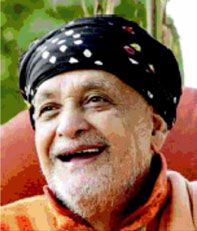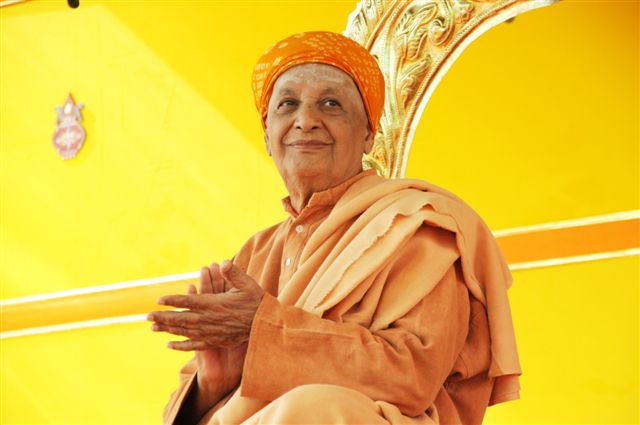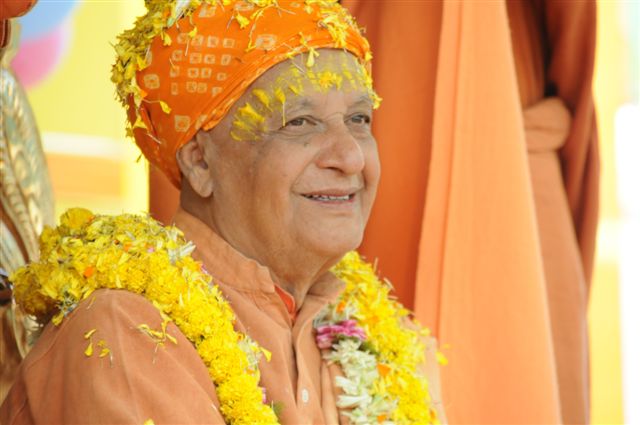Satsang by Swami Satyananda
The aim of life is to acquire jnana, wisdom, to contemplate on God and creation. Dogs, cats and elephants cannot do this, only humans can. Only humans can contemplate, discuss God, say that God exists or say that He does not exist. They can perform worship, read the Ramayana, and think about birth and rebirth. No other species can do this. Only humans have been blessed with this faculty. Thus, this faculty should not be used merely to cook food, wash clothes, produce children or get married. These are things that must be done, but they cannot be the aim of life. You are not born for this.
Darwin said that our ancestors were monkeys. But has anyone seen a monkey do arati, tulsi puja, Shivalinga puja or chanting a mantra? I don’t agree that monkeys were our forefathers; humans were directly born, God has produced the human species. They are His experiment to create at least one form that praises Him. God produced every creature in this creation, but none of them remembered Him. None of them saluted Him after being created. God thought that now He must create something which will say “Shri Rama ki Jaya”. So He created humans.
God discovered humans and humans discovered God. After this discovery, Christians put their God in paradise and Muslims put theirs in Jannat. And we put God in our hearts. Now, if God is somewhere else it will take a while to reach him, but if God is within us, then we can see Him by just taking a peek inside. Spend a few moments to look within at God’s beauty, and then you may look outside and admire your wife’s beauty. This ability is the speciality of a human, but he has not made use of it. Singing God’s name and spiritual life are not the main themes of his life. He is busy running after a job and marriage. He looks after his son, daughter and father, but he never remembers the name of God. He goes to the temple and offers flowers only when he is faced with a problem. That which was the main subject has become secondary. Contemplating on God and spiritual life are no longer our main concerns; they have become optional while worldly life has become compulsory, although this should be reversed.
Why has man moved away from God? This has been the trend from the very beginning. The term ‘religion’ explains this. ‘Re’ means again and ‘liaison’ means to get attached. This means that once you were one with God, you had a connection with Him, but now you are free to remake that bond. Religion doesn’t mean a sect; religion means reunion, re-establishing a connection. The first connection was that God created us. He is within us. We and God are one. However, due to ignorance we drifted away from Him. Then something reconnected us with God, we again started thinking about God, and that something is religion.
The saints and sages, the Upanishads and the Vedas have asked this question again and again – what is the reason that man who is in God’s own image, who is God’s legitimate child, broke his connection with God? Why did the jivatma, individual soul, move away from Paramatma, Supreme Spirit, towards maya, illusion? Why does he have such a tendency? These questions are not new, they have been asked for thousands of years. Why does he behave like dogs and pigs? Why does he hold on to things which cause sorrow, pain and harassment?
The reason is long. The Samkhya philosophy explains it well. It says that when God united Purusha with Prakriti, then the world was created, living beings were created. Creation would not have come about without the union of Purusha and Prakriti. God would have been sitting alone as formless, pure and unborn. Thinking Ekoham – “I am one”, He would have remained formless in the eternal void. So, the Upanishads say that once upon a time a sankalpa, resolve, formed in the mind of God: Ekoham bahusyam, “I am one, let me become many.” And then the story is told about how the cosmic egg hatched, how quadrupeds and bipeds were created, how eighty-four lakh yonis, species, were created.
All this happened through the union of Purusha and Prakriti. Just as a gram would not sprout if both its parts were not together; if Purusha and Prakriti are separated, the world will be destroyed. Kabir says:
Isa bangle me eka achambhaa
Naari purusha kaa jodaa
Kahata Kabira suno bhaee sadho
Jina jodaa tina todaa.
This house holds a wonder in it
A man and a woman live in here.
Kabir says, listen to me,
One who unites them also separates them.
Here, union refers to dhyana yoga and separation to separation of Purusha from Prakriti. Purusha and Prakriti are separated through dhyana because Prakriti means matter and Purusha means consciousness. Prakriti is not a woman; it is an element which has three qualities or gunas: sattwa, rajas and tamas. With the help of these three gunas, Purusha creates the world. Every individual is born with these three gunas. We are all principally rajas and tamas dominated creatures, and that is why we always go outwards although we are a part of God.
This has been explained very well in the Ramacharitamanas. The entire story is a symbolic answer to this question: why is the individual soul in bondage? Why does maya delude him and take him away? How is he then liberated? Ravana’s ten heads represent the five karmendriyas, organs of action, and five jnanendriyas, organs of knowledge. Whatever knowledge you acquire and utilize, is done through these ten senses. Every individual is swayed by these senses, just as Ravana was able to kidnap Sita. The Ramacharitamanas is an answer to all our questions. It answers all questions on bhakti as well as jnana.




